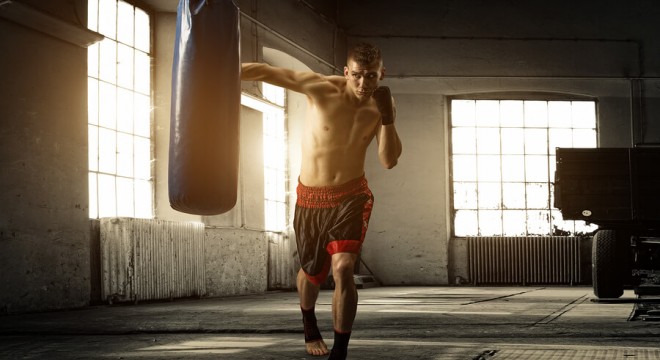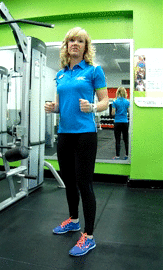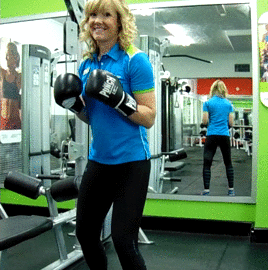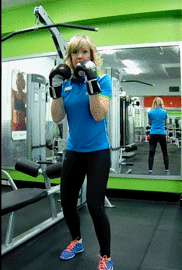The Fitness Zone

Fitness Boxing Basics
Boxing is a fantastic workout for PT clients or solo gym-goers. It requires speed, agility, fitness, power, endurance and ultimate mental toughness. Boxing has a potential burn rate of 13 calories a minute, which makes for quite an impressive workout if you want to get a fighter’s physique. Boxing takes on other cardio activities such as cycling and running and works predominantly on the upper half of the body. Meghan Jarvis, fitness coach in Queensland, shares some basic fundamental rules to remember when boxing as a beginner.
1. Ensure clients have the proper stance.
This includes having the front toe and back heel on the centre line, with the back foot being the side of the dominant hand. Weight evenly distributed, with the feet diagonal and a little wider than shoulder width apart to ensure balance. Knees should be slightly bent whilst standing and after throwing a punch, always return back to the original stance.

2. Relax Being relaxed is the only way to exert powerful force repeatedly, without getting tired out and having to stop.
Muscles must be calm and fluid, allowing energy to flow through the entire body during punches. Being tense stops the energy from flowing and prevents punches to be thrown with full power.
3. Eyes on the prizeClients should have their eyes on the partner/opponent at all times.
Ensure they are looking at the target, maintain safety for both the boxer and the pads holder. Don’t look around at where you might be punching if you’re aiming for the body. Instead, focus on eye contact and using your peripherals.
4. Resting Position Arms should rest with the elbows down and hands up.
The head is behind the gloves, chin slightly down and eyes over the gloves (facing the opponent’s eyes). Encourage clients to return to this position after all boxing movements.

5. Pivot During all punches except for the jab, client’s whole body should turn and feet should pivot as if there is a string attached from their knee to their elbow.
This should be done while maintaining their stance and balance for better power, mobility and core engagement. The non-punching hand is defending the other side of the body at all times and not dropping.
6. Exhale sharply on every punch Aim to develop a short and explosive exhalation, mirroring the effort provided by the punch.
This helps to get more into the ebb and flow of your movement to help you relax and throw more powerful punches.
7. Get to know your punchesJab:
Starting from the starting position, punch with your left hand by twisting the arm slightly so that the knuckles are up and your palm is facing down. Your movement should “snap” at the end and return back to the starting position, which will serve to protect your face. Pivot on the ball of your left foot and take a small step forward on your right foot as you punch.
Uppercut: From the beginning stance, bend the knees and turn slightly towards your opponent. Using your dominant hand, punch straight up from under your opponent’s chin. Use your bent knee to drive power into your punch and keep your other hand close to your face to protect it from any incoming punches from your opponent.
Cross: Just like the jab punch, throw the punch towards your opponent, twisting your arm so that knuckles are facing up and palm is facing down. The difference is your stance as you will be turning your torso towards your opponent. Keep your front foot grounded and use the back foot to pivot the body.
(Left) Hook: From your starting position, lift your left arm so that it is at nose height and forms a right angle in front of you. At the same time, pivot your feet turning your torso and adding force behind your punch. The force of the punch should all come from the power in your legs and body used to throw the hook.
8. Recovery
When throwing the punch, clients should recover the punching arm approximately to its original position as quickly as they threw it. This can assist in decreasing vulnerability and the sooner the next punch can be thrown.

You don’t have to be throwing punches at another person if you’re not comfortable doing so. It is best to learn the basics with a trainer, punching pads or a punching bag. It is, however, a really great form of exercise. By following these simple guidelines, clients will be safe and getting the most out of their boxing sessions.
Boxing can be a very fun workout for all levels of fitness. If used in a safe and correct manner, it can be a great way for clients to achieve fitness goals. Whether you’re sparring with another person or your trainer, or going solo at the gym with a punching bag, you can burn a great amount of calories if you put the effort in.
Read more articles
Disclaimer: Where Certificate III in Fitness, Cert III/Cert 3, or Fitness Coach is mentioned, it refers to SIS30321 Certificate III in Fitness. Where Certificate IV in Fitness, Cert IV/Cert 4, or Personal Trainer is mentioned, it refers to SIS40221 Certificate IV in Fitness. Where Master Trainer Program™ is mentioned, it refers to Fitness Essentials and SIS40221 Certificate IV in Fitness. Where Master Trainer Plus+ Program™ is mentioned, it refers to SIS30321 Certificate III in Fitness and SIS40221 Certificate IV in Fitness. Where Certificate IV in Massage or Cert IV/Cert 4 is mentioned, it refers to HLT42021 Certificate IV in Massage Therapy. Where Diploma of Remedial Massage is mentioned, it refers to HLT52021 Diploma of Remedial Massage.











